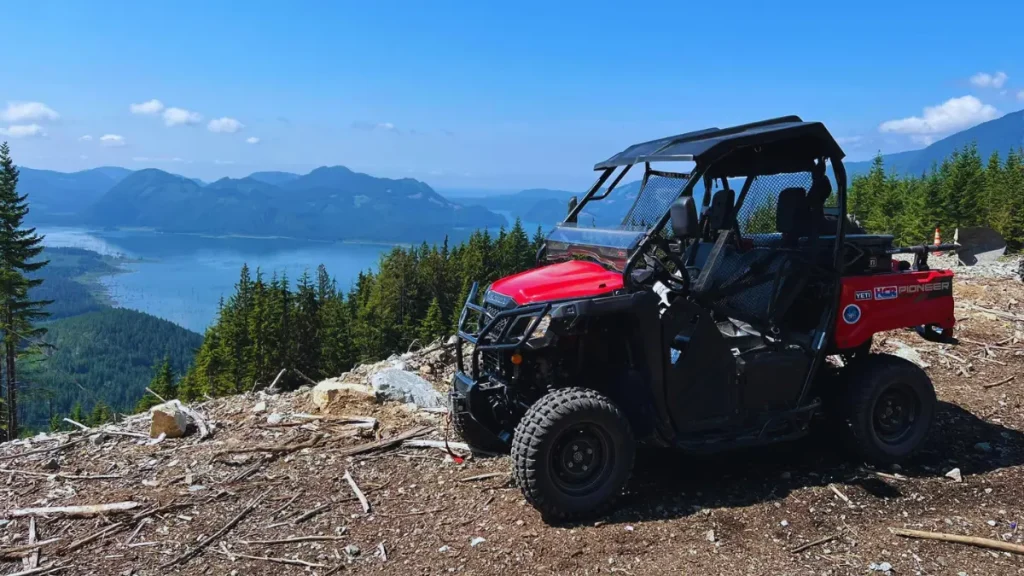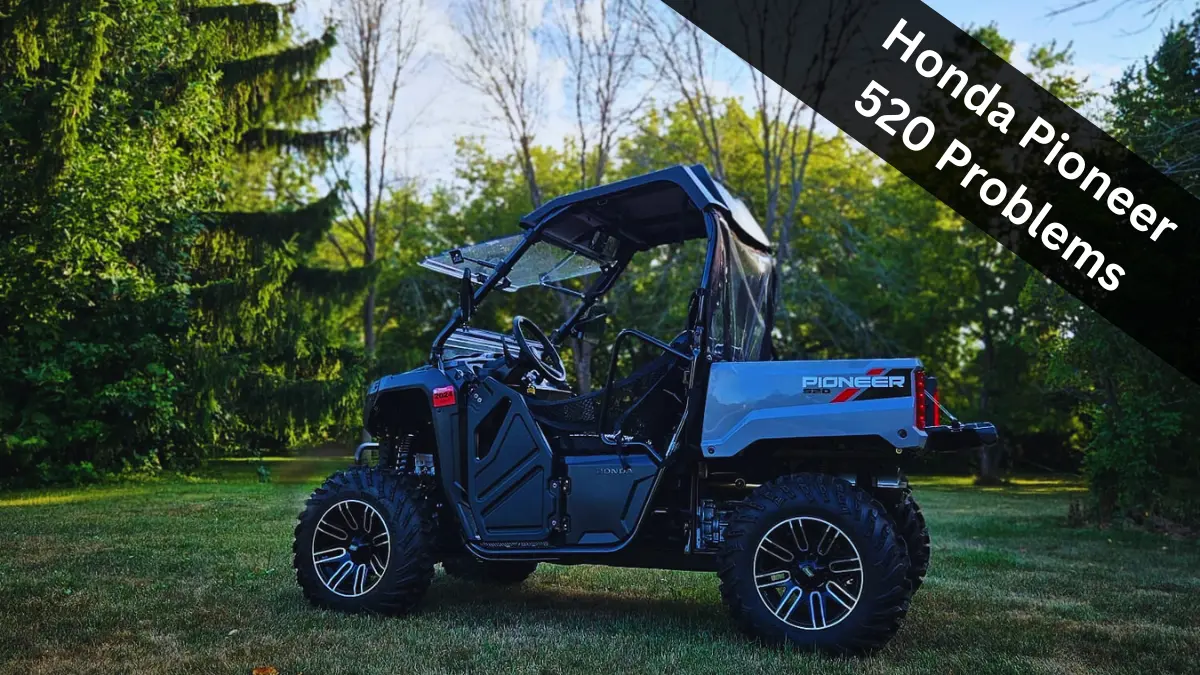If you read a review of the Honda Pioneer 520, one of the main takeaways is that this model has minimal issues and should require little replacing or repairing of parts and components through the years.
This is also true for the other Pioneer models, as evidenced in this review of the Pioneer 500, this detailed Pioneer 700 review, and a review of the Pioneer 1000.
But while the Pioneer 520 is known to be one of the most durable and dependable utility side-by-sides in the industry, they’re not flawless.
This guide will detail the six most common Honda Pioneer 520 problems and owner complaints, including:
- Harsh Gear Shifting
- Squeaking From The Rear Cargo Bed
- A Jolting Ride When Off-Road
- Heat In The Cab & Under The Seats
- Restricted By A Speed Limiter/Rev Limiter
- Seat Belt Safety Feature
Most of these issues can be overcome rather easily, which will be detailed as well.
6 Most Common Honda Pioneer 520 Problems
Harsh Gear Shifting
The most commonly voiced problem and displeasure among Pioneer 520 owners is with the tendency for new units to shift very rough.
When driving their new Pioneer 520, you’ll very likely be able to really feel the automatic gear shifts taking place, especially as the machine is downshifting.
Some owners have even described these shifts as “violent” and somewhat jokingly claim it will give you whiplash if you’re not prepared for it.
This hard shifting is a result of the unique transmission in the Pioneer models, which doesn’t make use of a drive belt.
While the lack of a drive belt should make these models more durable over time and cut out the maintenance, repairs and issues known to stem from drive belts, it leads to this rough shifting as the metal gears work themselves in.
Fix
This harsh shifting is much more common when driving in Automatic mode and is less noticeable when driving in Manual, so you can overcome it by driving in Manual.
But who wants to drive in Manual all the time?
Luckily for the 99% of us who don’t, these rough gear shifts smooth out on their own as the transmission and gears work themselves in.
Usually after the first 100 miles or so of driving the problem is much less noticeable, and by 200 miles in or after the first oil change, the gear shifts should be pretty much completely smooth.
It’s annoying while it lasts, but this issue is the tradeoff for not dealing with drive belt issues down the road.
Squeaking From The Rear Cargo Bed
Another common issue experienced in the Pioneer 520 is a constant squeaking noise coming from the rear cargo bed area while driving.
Imagine a gnat buzzing in your ear constantly, and you’ll understand how this constant squeaking can drive a man mad.
Fortunately, the cause of this squeaking has been identified and there’s a simple fix.
Fix
If you have squeaking in your model, it’s most likely coming from either the rubber pads on the dump bed when it is closed, or from the hooking mechanism for the dump bed.
Simply applying some grease to these rubber pads/stops and to the hook mechanism should completely quiet this squeaking as quick as a smack would quiet that gnat in your ear.
You’ll likely need to reapply grease every so often to keep the squeaking in check, but this should do the trick.

Jolting Ride When Off-Road
This is more-so a drawback than a problem, but it’s worth noting as it’s one of the more common complaints.
The Pioneer 520 is a very compact model, which comes in handy in that you can load it into the bed of a full-sized pickup.
But at only 50 inches wide, it’s wheelbase is quite small and the suspension system offers limited travel.
This leads to a rough ride when riding at any bit of speed off-road, and you can get jolted around pretty good inside the cab by bumps, holes, and ruts in the terrain.
To add to this, the stock tires are pretty small. Besides the fact that they make this UTV look a bit more like a glorified golf cart, they also lend to this rough ride when off-road.
Fix
As you can probably guess, the only real fix for this is to make some modifications to the Pioneer 520 in order to get a smoother ride.
Adding bigger, wider stock tires is a good starting place. But this will only go so far in making the ride noticeably smoother.
Many owners choose to outfit their Pioneer 520 with some aftermarket shocks, which increase the suspension travel and ground clearance enough that it makes trail riding and other rough terrain much smoother.
Walker Evans shocks are the preferred brand of many Pioneer 520 owners, but there are other options out there as well if you want to shop around.
Heat In The Cab & Under The Seats
Another common problem in these models is that warm air vents into the cab area and warms the underside of the seat, making the seats get pretty hot in the middle by the seat belts where it vents through the belt holes.
As you can imagine, a heated seat in the middle of the summer can lead to an uncomfortable ride on already-hot days, and the warm air venting into the cab essentially serves as a heater and amplifies this.
Fix
The only real fix for this is to purchase or make a heat shield.
You can buy a heat shield online that is specific to these models, which is a rubber liner that fits under the seat and blocks the heat from venting into the cab area.
You can also fashion your own heat shield that fits under the seat and serves the same purpose if you’re handy and would prefer a cheaper DIY option.
Restricted By A Speed Limiter/Rev Limiter
One of the most common complaints with the Pioneer 520 is with how slow they are.
These models will barely top out at 39 mph, which is their top speed in stock form. That makes a few of the Kawasaki Mules the only comparable competitors they’re faster than.
And when you have the pedal to the medal and you’ve reached this top speed, many times the engine will almost “hiccup” and may sound like it’s going to explode.
It won’t as the speed/rev limiter kicks in here and the RPMs will fall off, but it can still be concerning to experience while driving.
Fix
The only fix for this is to bypass the speed limiter, which can only be done by having the stock ECU tuned.
A tune will essentially delete the electronic speed limiter, but will only really add between 5-8 mph of top speed as a result.
The Honda engines are simply not built to go that fast, and they’re happy to let you know it.
Seat Belt Safety Feature
Last but not least is the ever-complained about seat belt safety feature installed in every Pioneer model and most other utility side-by-sides these days as well.
The seat belt safety feature essentially prevents the vehicle from getting out of Limp Mode if the driver’s side belt isn’t buckled while driving.
This feature is in place with good intentions, but can be a real annoyance when you’re doing stop-and-go working tasks around the property as you have to buckle and unbuckle constantly.
Fix
There are a couple of different fixes for this.
The easiest one seems to be to simply buckle the seat belt behind you and not utilize it as you ride, or to buckle the passenger side belt into the driver’s side belt buckle to trick the safety feature.
There are also seat belt buckle blanks you can purchase online to insert into the buckles to trick them as well.
Final Word
Many of these common problems are admittedly pretty nit-picky and not deal-breakers, which speaks to the high quality builds of these machines.
That said, some of these problems and drawbacks can be worrisome and a real headache for owners, so they’re good to know about when considering buying a pricey machine like the Pioneer 520.
But fortunately, most of the Pioneer 520’s common problems are fairly easy to overcome.
You can check out the common problems with the other Honda Pioneers here:


